User Guide
- Introduction
- Application Features
- Quick start
-
Commands
- Adding a flash card:
add - Deleting a flash card:
delete - Editing a flash card:
edit - Listing all flash cards :
list - Finding a flash card:
find - Filtering list with specified language:
language - Getting list for revision:
review - Starting a new review session :
start - Ending the current review session:
end - Revealing the other side of the flash card:
reveal - Indicating user has memorized the word:
yes - Indicating user has forgotten the word:
no - Show learning statistics:
stats - Loading list of words:
load - Switching color theme:
switch - Viewing help:
help - Exiting the program:
exit - Saving the data
- Editing the data file
- Adding a flash card:
- FAQ
- Command summary
- Glossary
Introduction
Flashlingo is a versatile desktop application centered around learning words through flash cards. It is optimized for use via a Command Line Interface (CLI), while also providing the advantages of a Graphical User Interface (GUI). Tailored with a focus on beginner language learners with beginner level of proficiency in command line, Flashlingo specializes in expanding vocabulary. If you are not familiar with the command line interface (CLI), you can refer to the Glossary section below, and the Command Summary section for a quick overview of the commands.
By incorporating Leitner system, Flashlingo schedules review sessions, ensuring words are revisited at optimal intervals to enhance long-term memory retention. This method assists users in effectively retaining and expanding their vocabulary over time.
Application Features
Flashlingo predominantly consists of two main features: Managing flash cards and Reviewing flash cards
-
Managing flash cards
- Users are given the ability to add, delete and edit flash cards. And each flash card is assigned with a
level, which indicates the proficiency of the user with the word. The level of the flash card will be updated after each review session.
- Users are given the ability to add, delete and edit flash cards. And each flash card is assigned with a
-
Reviewing flash cards
- In each review session, words that require reviewing will be presented to users one by one. For each word, users can indicate whether they have
- memorized the word
This will advance the word into the nextlevel, meaning less frequent review for the word in the near future. - forgotten the word
This will decrease thelevelby 1, meaning more frequent review for the word in the near future.
- memorized the word
- In each review session, words that require reviewing will be presented to users one by one. For each word, users can indicate whether they have
![]() Notes about the level:
Notes about the level:
-
The higher the
Levelis, the higher the proficiency of the user with the word is. The maximum level is 5, and it will be displayed asword mastered. -
Words which are indicated as
word masteredwill not appear in review session.
With each review frequency scientifically determined by Flashlingo, it will make your vocabulary learning an absolute breeze, meaning you can spend less time and memorize things more enduringly.
Quick start
-
Ensure you have Java
11installed in your computer. -
Download the latest
flashlingo.jarfrom here. -
Copy the file to the folder you want to use as the home folder for your Flashlingo.
-
Open a command terminal,
cdinto the folder you put the jar file in, and use thejava -jar flashlingo.jarcommand to run the application. Below shows the steps to perform such a task- Open up the terminal.
- For mac users, press
Command + Spaceto open Spotlight search, typeTerminal, and pressEnter.
- For windows users, press
Windows + R, typecmdand pressEnter.
- For mac users, press
- Navigate to the folder containing the jar file. In this example, it is in the Downloads folder. So the command is:
cd DownloadsClick here for more information on how to navigate to a folder in the terminal.
-
Simply type in
java -jar flashlingo.jarto get started!A GUI similar to the below should appear in a few seconds. Note how the app contains some sample data.

- Open up the terminal.
Using the application
-
Type the command in the command box and press Enter to execute it.
-
The image below shows the result of typing in a command. A log message will be displayed below the command box to give information about the outcome of the command.
-
Refer to the Commands below for details of each command.
Commands
![]() Notes about the command format:
Notes about the command format:
| Notation | Description | Example Command | Example Usage |
|---|---|---|---|
<PARAMETER> |
Parameter to be supplied by the user | delete <INDEX> |
delete 1 |
[<OPTIONAL>] |
Indicates an optional parameter | add w/<WORD> t/<TRANSLATION> [wl/<WORD_LANG>] [tl/<TRANSLATION_LANG>] |
add w/Hello t/你好 |
<PARAMETER...> |
Commands that can take in multiple comma separated parameters | find <KEYWORD...> |
find hello, bye |
... |
Parameter that will not be used | help ... |
help 123 is the same as help
|
![]() Notes about the command output:
Notes about the command output:
... in the command output shown below depends on user input and details of the existing flash cards.
|
|
|
|---|---|
add delete edit find start list load language review stats
|
yes no end
|
Error Message: Sorry, currently you are in a review session. Your command is not supported. Please end the review session first.
|
Error Message: You are not in a review session.
|
Adding a flash card: add
![]() Notes about adding words:
Notes about adding words:
- In order to give users full customizability, there’s no any restriction on input, as long as it is not empty.
Adds a word to the flash card with its translation.
- Creates a wild flash card.
- Works to add a word with its translation in their respective languages.
- The already saved translation can be overridden with a new translation in a different language.
Command Format: add w/<WORD> t/<TRANSLATION> [wl/<WORD_LANGUAGE>] [tl/<TRANSLATION_LANGUAGE>]
The default language for both word and translation is blank (
"")
Examples:
-
add w/雪 t/snowsaves the translation of 雪 as snow -
add w/雪 wl/Chinese t/snow tl/Englishsaves the translation of the Chinese word 雪 as an English word snow
Output:

Note
- Flash cards are case-insensitive. The following commands are the same:
add w/CIAO t/hello/byeadd w/ciao t/HELLO/BYE
- Users can add two flash cards with the same word and translation BUT in different language
The following three commands will not cause duplicate error:add w/雪 t/snowadd w/雪 t/snow wl/Chinese tl/Englishadd w/雪 t/snow wl/Japanese tl/English
- Users are not allowed to add a flash card with the same word and translation
The following command will cause duplicate error:add w/sorry t/sorryadd w/sorry t/SORRY
- Users are not allowed to add a flash card with the empty word or translation
Deleting a flash card: delete
Deletes a flash card and its related information
- Deletes a flash card.
Command Format: delete <INDEX>
Examples:
-
delete 2deletes the word and its translation at index 2
Output:
| Before delete | 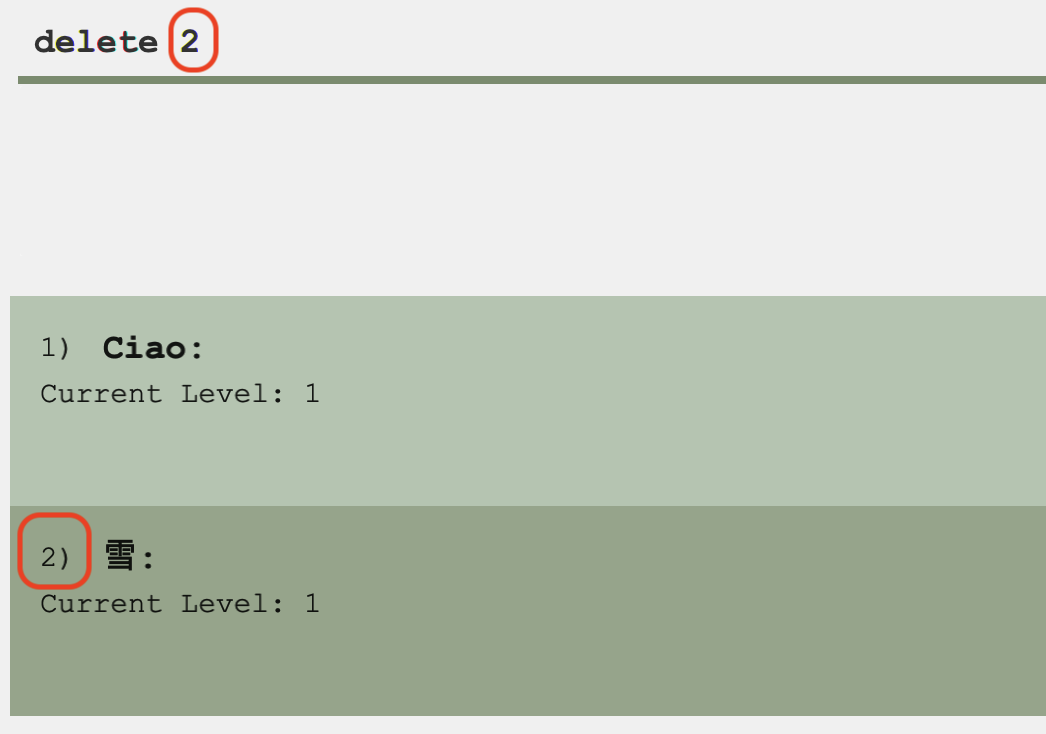 |
|---|---|
| After delete |  |
Editing a flash card: edit
Edits the specified flash card at the given index.
Command Format: edit <INDEX> [w/<WORD>] [t/<TRANSLATION>] [wl/<WORD_LANGUAGE>] [tl/<TRANSLATION_LANGUAGE>]
Examples:
-
edit 1 w/こんにちわ t/Helloedits the translation at index 1
Output:
| Before edit | 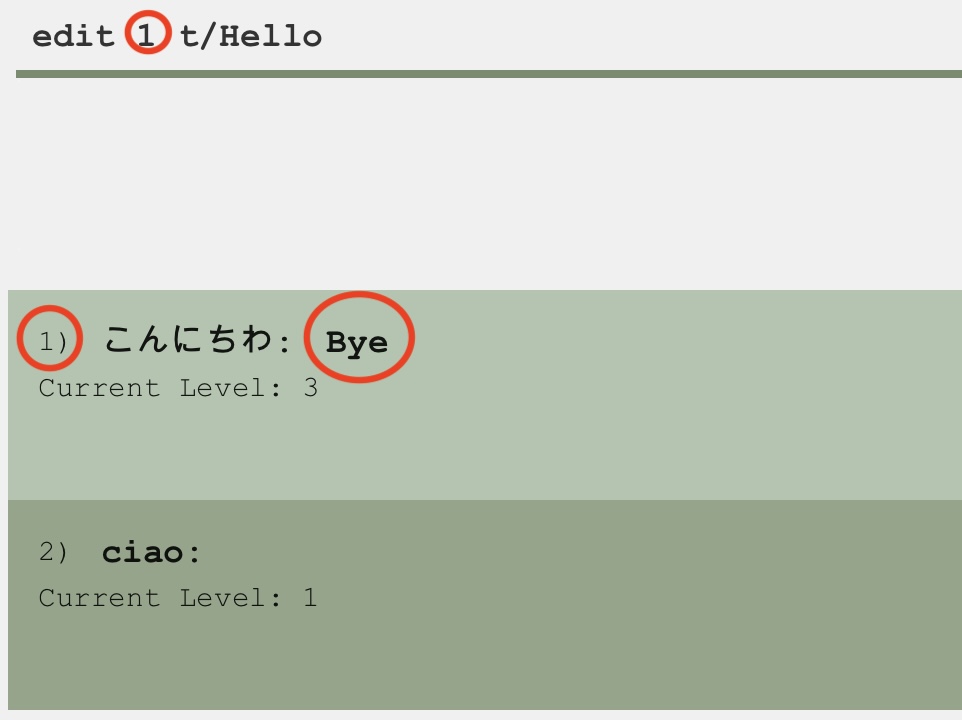 |
|---|---|
| After edit |  |
Note
-
<INDEX>is the index of each flash card in thelist - Users must change at LEAST one certain parameter by using certain prefix
- Word:
w/WORD - Word Language:
wl/WORD_LANGUAGE - Translation:
t/TRANSLATION - Translation Language:
tl/TRANSLATION_LANGUAGE
- Word:
- Users are not allowed to edit a flash card to an existing flash card
The error message:
This flash card already exists in Flashlingo!
Listing all flash cards : list
Shows the list of flash cards with both the original word and the corresponding translation.
- Lists all the flash cards saved
Command Format: list ...
All the saved flash cards, regardless of the review date, are listed.
Output:

Note
-
listcommand cannot be used during a review session- To facilitate learning, only the flash cards - that are to be reviewed - can be seen during the review session.
- As soon as the review session ends, all the flash cards can be listed once again.
Finding a flash card: find
Filters the flash card list by the given keywords. All the flash cards whose word or translation contains at least one of the keywords will be displayed.
- The search is case-insensitive. e.g
foodwill matchFood
Command Format: find <KEYWORDS...>
Examples:
-
find foodreturns the flash card list and its translation that contains the keywordfood -
find ooreturns the flash card list and its translation that contains the substringoo -
find food, byereturns the flash card list and its translation that contains the keywordfoodorbye
Output:
| Before find | 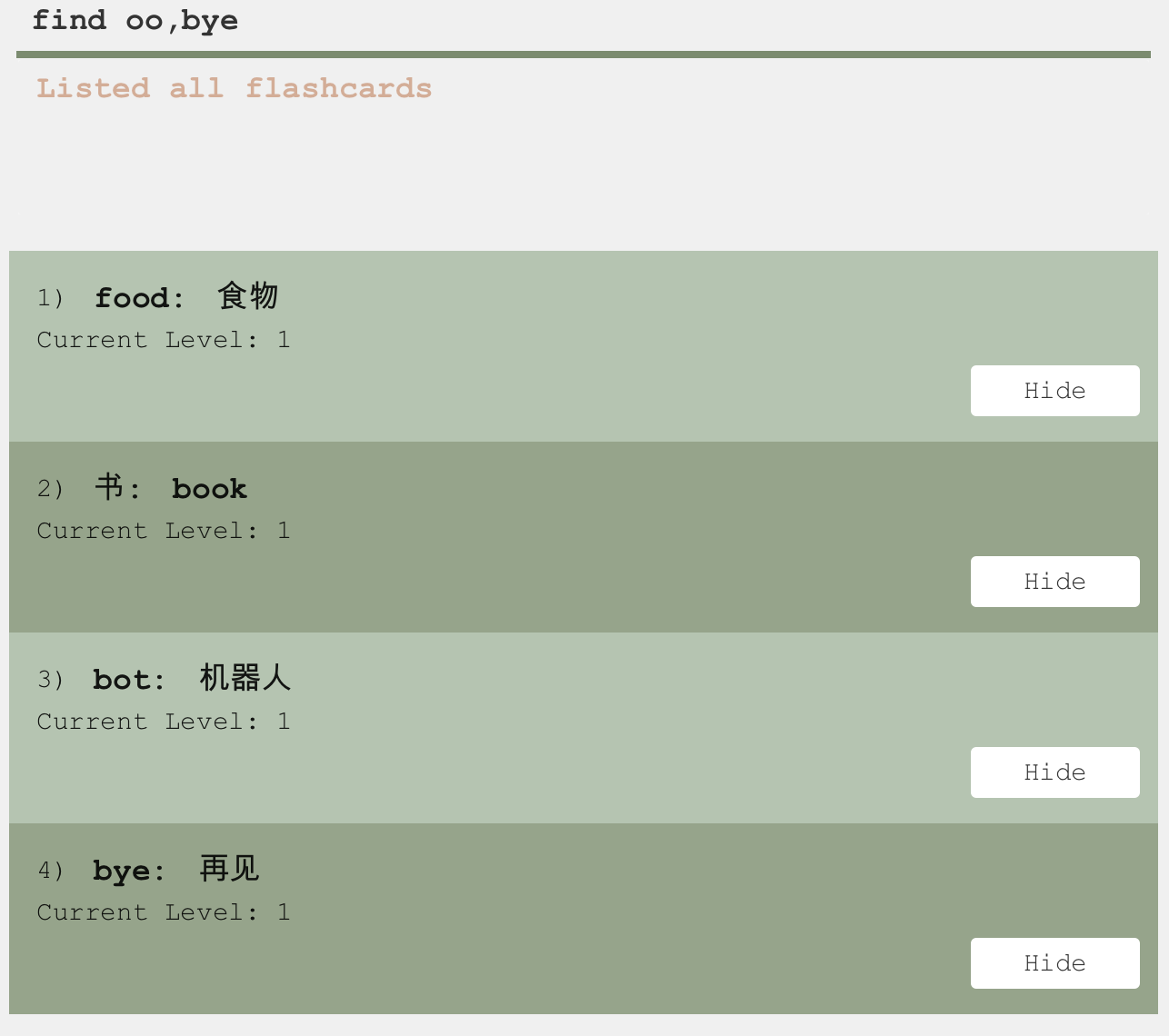 |
|---|---|
| After find | 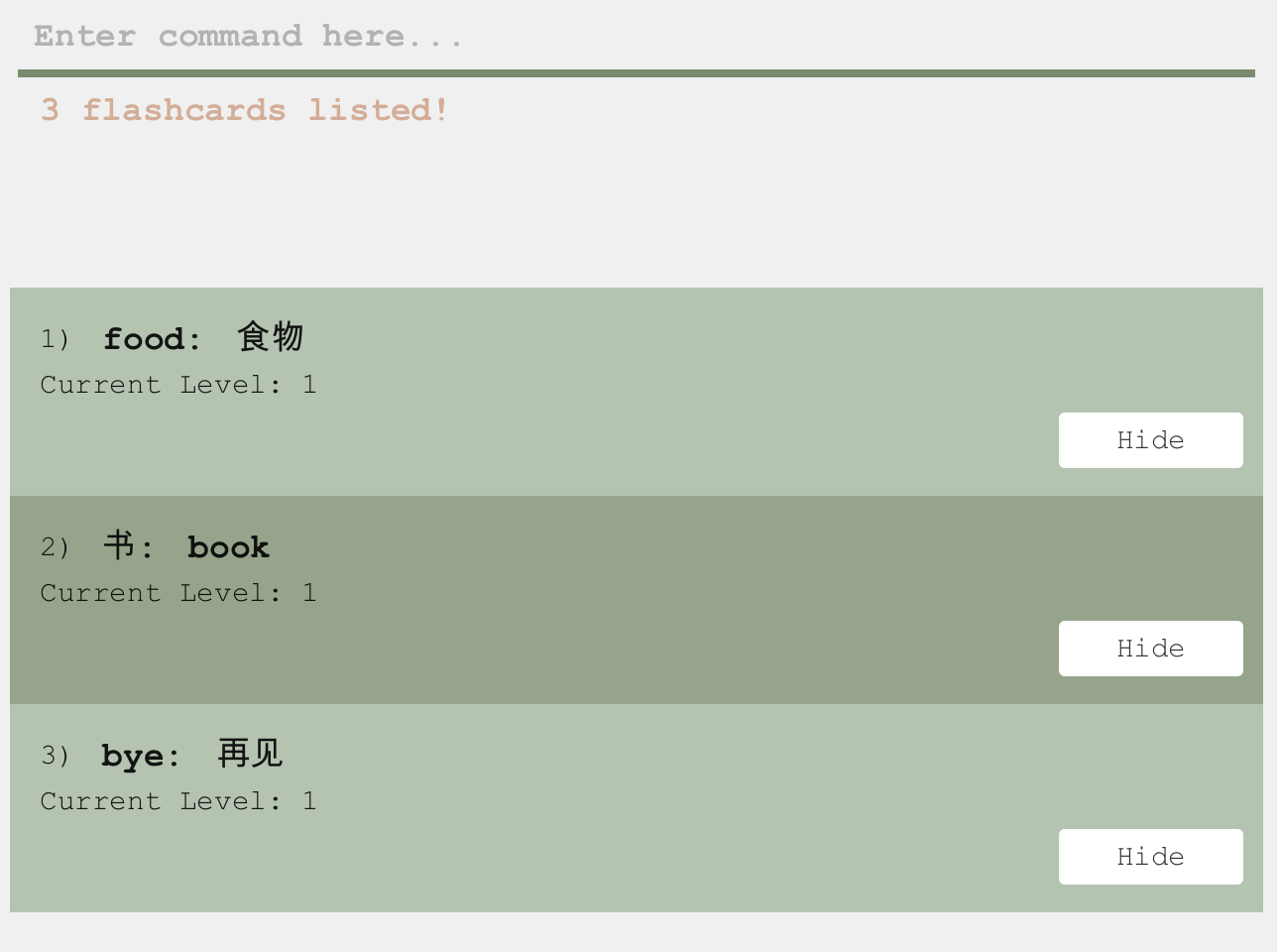 |
Filtering list with specified language: language
Filters the list of flash cards by the specified language. All the flash cards whose word or translation is in the specified language will be displayed.
- The search is case-insensitive. e.g
frenchwill matchFrench
Command Format: language [<SPECIFIED_LANGUAGE>]
Examples:
-
language Frenchdisplays a list where each word or translation is from French language.
Note
- Unlike the
findcommand, thelanguagecommand uses exact search. So it will not display the flash cards whose word or translation contains the specified language as a substring or keyword.- e.g.
language Chinesewill not display following flash cards:w/读书 t/read book wl/简体中文 tl/Englishw/讀書 t/read book wl/Traditional Chinese tl/English
- e.g.
-
languagewithout any parameter will display all the flash cards with default language"".
Getting list for revision: review
Displays the flash cards of all the words to be reviewed that day
- The review command will present flash cards selected by Flashlingo based on your level, as well as the interval between the last review, utilizing the Leitner system.
- If you wish to view all your saved flash cards without the Leitner system’s selection criteria, please use the
listcommand.
Command Format: review ...
Output:
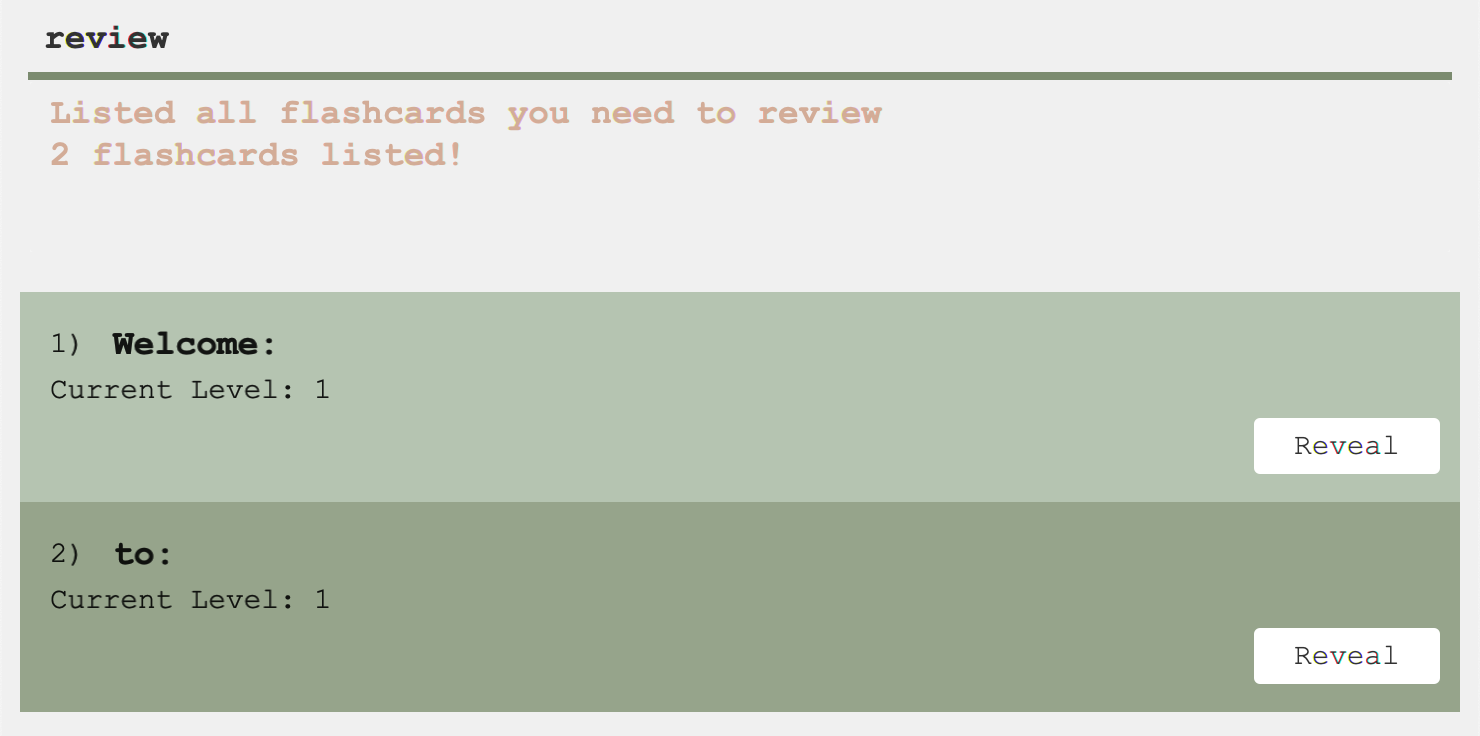
Note
- The message
0 flashcards listed!occurs when:- There are no flash cards scheduled for review at the time when the command is executed.
Starting a new review session : start
Starts a new review session.
Command Format: start ...
Output: Review Session has been started.
Note
- If there are no words to review, users will not be able to start review session.
You have no more words to review!will be displayed.
Ending the current review session: end
Ends the current review session and returns to the main menu.
Command Format: end ...
Output: Review Session has ended.
Revealing the other side of the flash card: reveal
Shows the translation of the flash card given by index if it is hidden. Otherwise, hides the translation of the flash card.
Command Format: reveal [<INDEX>]
Output :
| If translation is hidden |  |
|---|---|
| If translation is revealed | 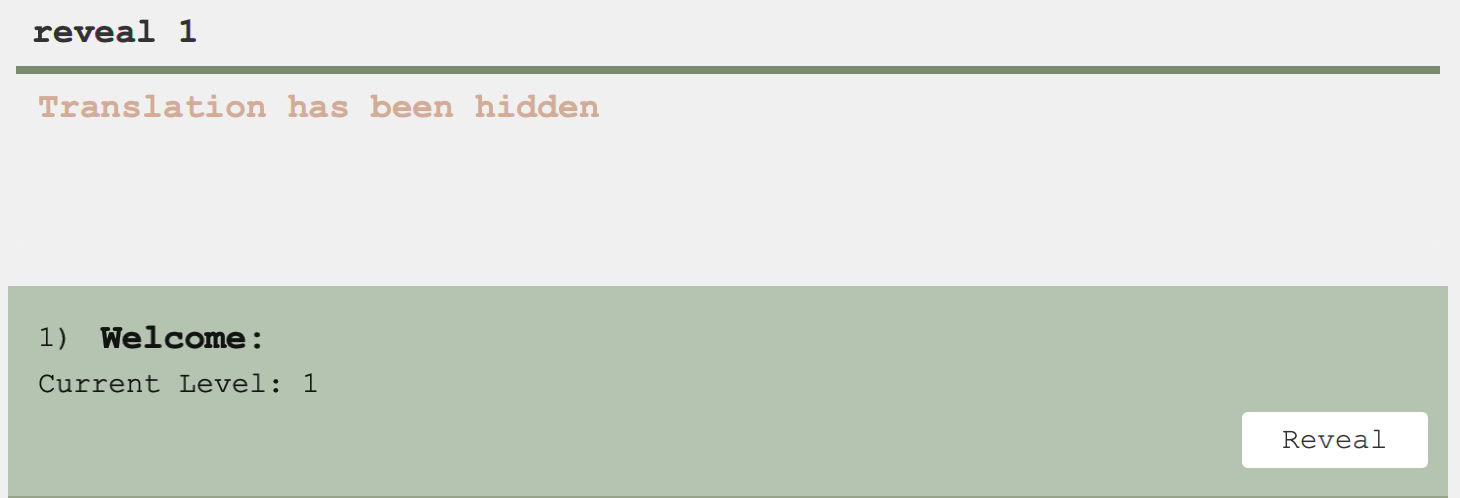 |
![]() Notes:
Notes:
- When
<INDEX>is omitted, the default value is 1. - Pressing
revealorhidebutton will have the same effect. - In future enhancement, this command will be renamed to
flipto better reflect its function.
Indicating user has memorized the word: yes
Marks the word as memorized and advances the word into the next level. If there are still remaining words to review,
they will be automatically shown in the section below. Otherwise, review session will be closed by default.
Command Format: yes ...
Output:

Note
- Pressing
yesbutton will have the same effect. - In the case where there are no more words to review,
The next word is:will be replaced by
You have no more words to review!.
Indicating user has forgotten the word: no
Marks the word as not grasped and decreases its level by 1. If there are still remaining words to review,
they will be automatically shown in the section below. Otherwise, review session will be closed by default.
Command Format: no ...
Output:

Note
- Pressing
nobutton will have the same effect. - In the case where there are no more words to review,
The next word is:will be replaced by
You have no more words to review!.
Show learning statistics: stats
To help track user progress and inspire continued learning, this command offers detailed statistics:
- Total Flash Cards: Displays the total count of flash cards you have saved.
- Remembered Words: Shows the number of terms you have successfully retained in this session.
- Success Rate: Presents a percentage representing your learning success for this session, motivating you to keep improving.
Command Format: stats ...
Output:

Note
- The success rate is calculated solely on the basis of the current session.
Loading list of words: load
Loads an Excel file of words into the app. The words will be added to the current list of flash cards and included in the review session automatically.
Command Format: load <FILE_NAME>
![]() Notes about the file input:
Notes about the file input:
-
File format: The file must be an Excel Workbook with the
.xlsxextension. -
File location: The file must be located in the same folder as the
flashlingo.jarfile. -
File name: The file names, with and without the
.xlsxextension depend on different systems, should not contain leading or trailing spaces. -
File content: The app only reads the first two columns of the first sheet of the file.
- The sheet must contain only the following two columns (cannot have blank columns on the left):
- Column A - The original words
- Column B - The translation of the words
- The sheet cannot contain empty rows in between all rows with words.
- The sheet must contain only the following two columns (cannot have blank columns on the left):
- Resources: A sample file can be found here.
Output:
-
You have successfully loaded file: ...: Successful loading. -
File not found or accessible:
⚠️ Make sure the file is in the correct directory with read permission. -
File cannot be read due to invalid content or format:
⚠️ Make sure the file contains only two columns with the valid words/translations. -
... flash card already exists!:
⚠️ Modify the duplicated word/translation in the file to avoid duplication with the flash cards in the app. -
Word/translation cannot be empty!:
⚠️ Ensure all words and translations are not empty spaces.
Switching color theme: switch
Switches between light and dark appearance of Flashlingo.
- The theme will be saved and loaded when Flashlingo is restarted.
- Default color theme is the light theme.
Command Format: switch ...
Output:
| Light theme | 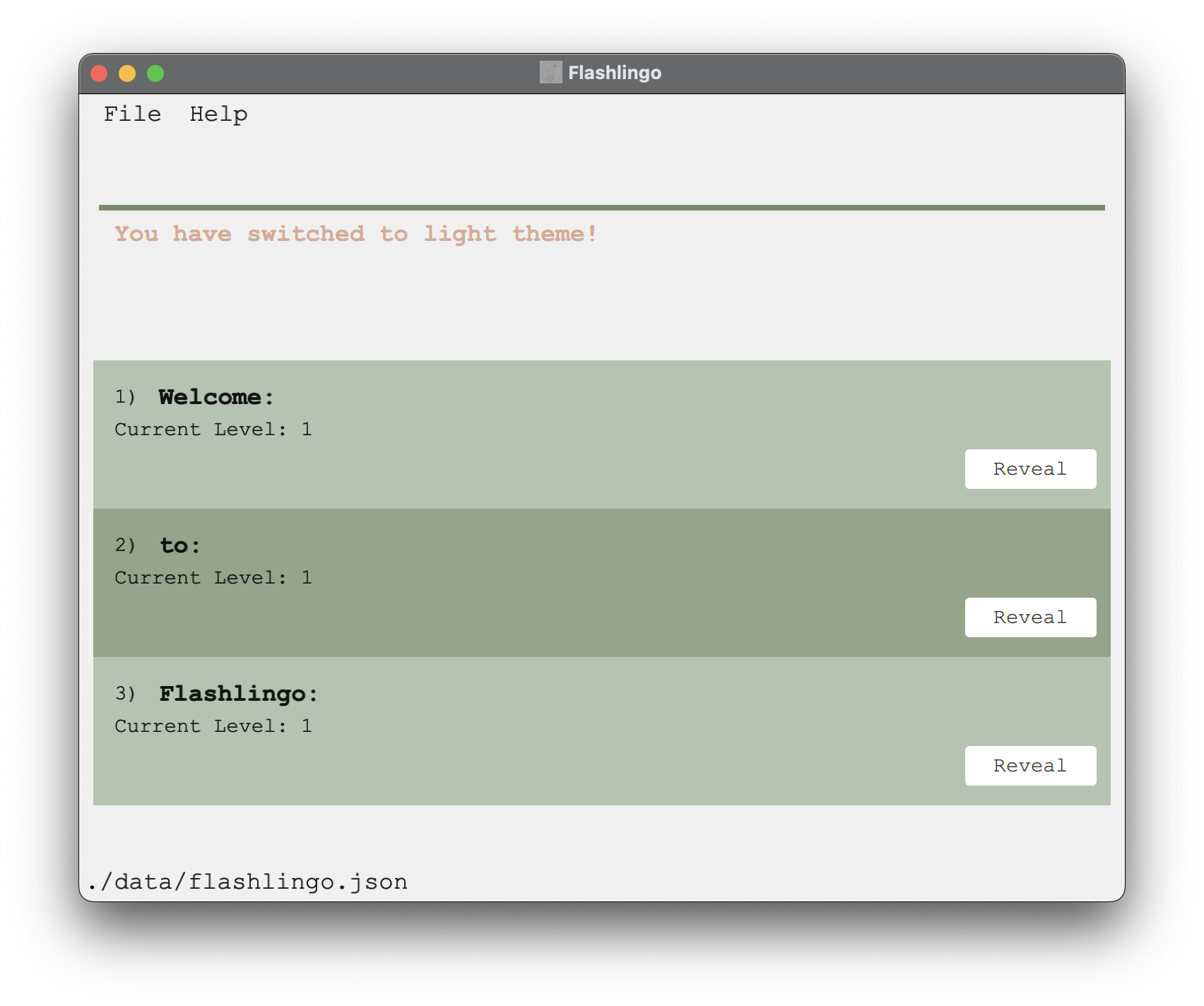 |
|---|---|
| Dark theme |  |
Viewing help: help
Opens a browser with the help page (User Guide). Pressing the Help button and then clicking Help F1 will achieve the same effect.
Command Format: help ...
Exiting the program: exit
Safely terminates the Flashlingo application and closes the graphical user interface (GUI).
Command Format: exit ...
Saving the data
Flashlingo data are saved in the hard disk automatically after any command that changes the data. There is no need to save manually.
Editing the data file
Flashlingo data are saved automatically as a JSON file [JAR file location]/data/flashlingo.json. Advanced users are welcome to update data directly by editing that data file.
FAQ
Q: How can I check if I have installed and am using the Java 11 version?
- Open up the terminal. Run the
java -versioncommand. The output should contain similar information to:version "11.0.X". - If Java
11is not installed, you may download it again. - If you are using lower or higher versions of Java, you may find switch version on Mac, Windows or Linux useful.
Q: How do I transfer my data to another computer?
Install the app on the other computer and overwrite the empty data file it creates with the file that contains the data of your previous Flashlingo home folder.
Q: How can I import my data to the app?
Save your words and translations in the specified format in an Excel file. Move the file to the same folder with flashlingo.jar.
Then, use the load command to import the data.
Q: What may be the reasons why my data cannot be loaded into the app?
- First, check your file name by opening the located folder. The file name should be directly displayed. Also, you can right-click the file to view the file name in its detailed info.
- If Flashlingo still cannot read the file, try inputting the file name with and without the extension
.xlsxin theloadcommand. This may solve potential issues with file name loading within different systems. - Secondly, ensure the content in your file is correctly formatted and valid. All rules can be found here.
- There may be issues with loading Excel if you have tried to delete data without using the delete whole row/column function. Copy the entire data (only valid rows and columns) to a new Excel file and try again.
Q: After I reviewed a flash card, I edited details of the card by the edit command. Will I be able to see these changes immediately reflected in the review session?
- Unfortunately, no. The card is updated synchronously in the card list and the review session of Flashlingo. However, since you have already reviewed the same card on the day, the card will not be included in the review session again.
- To check the card after editing, you can use the
listorfindcommand to locate the specific card. The changes will also be reflected in the next review session for that card.
Q: If the displayed level of a flash card is Word Mastered, what can I do if I want to review the card again?
- Currently, there’s no way for you to manually change the level of a flash card. Flashlingo is designed to automatically remove words that learners are familiar with from the review session.
- However, if you must review the card again, you can first use the
deletecommand to delete the card and then use theaddcommand to re-add the same card. The new card will be reset to level 1 and added to the review session.
Command summary
Refer to Commands if unsure of how to interpret the format.
| Action | Format, Examples | Supported Period |
|---|---|---|
| Add |
add w/<WORD> t/<TRANSLATION> [wl/<WORD_LANGUAGE>] [tl/<TRANSLATION_LANGUAGE>] e.g., add w/regarder t/look
|
Outside review session |
| Delete |
delete <INDEX>e.g., delete 1
|
Outside review session |
| Edit |
edit <INDEX> [w/<WORD>] [t/<TRANSLATION>] [wl/<WORD_LANGUAGE>] [tl/<TRANSLATION_LANGUAGE>]e.g., edit 1 w/bye t/再见
|
Outside review session |
| Find |
find <KEYWORD...>e.g., find bye
|
Outside review session |
| List | list ... |
Outside review session |
| Review | review ... |
Outside review session |
| Start | start ... |
Outside review session |
| End | end ... |
Inside review session |
| Reveal | reveal [<INDEX>] |
Both |
| Yes | yes ... |
Inside review session |
| No | no ... |
Inside review session |
| Learning Statistics | stats ... |
Outside review session |
| Language |
language [<SPECIFIED_LANGUAGE>]e.g., language French
|
Outside review session |
| Load |
load <FILE_NAME>e.g., load SampleData.xlsx
|
Outside review session |
| Switch | switch ... |
Both |
| Help | help ... |
Outside review session |
| Exit | exit ... |
Both |
Glossary
| Term | Definition |
|---|---|
| CLI | A command line interface (CLI) is a text-based interface where you can input commands that interact with a computer’s operating system. You can check the tutorial here. |
| GUI | A graphical user interface (GUI) is a digital interface in which a user interacts with graphical components such as icons, buttons, and menus. |
| JSON | JSON (JavaScript Object Notation) is a lightweight data format commonly used for representing structured data. |
| Leitner System | The Leitner system is a widely used method of efficiently using flashcards that was proposed by the German science journalist Sebastian Leitner in 1972. It is a simple implementation of the principle of spaced repetition, where cards are reviewed at increasing intervals. |
| Level | The level represents the proficiency with a specific flash card. The higher the Level is, the higher the proficiency of the user with the word is. |
| Review Session | A review session is a designated phase within the system where words requiring review are presented individually, based on Leitner System. Users can confirm their understanding or signal a need for further review. |